In this article, we reveal everything you need to know about tongue drums, including their history, how they work, and how to play them. Let's get started!
Introduction
Music is one of the oldest art forms on our planet. Thousands of years ago, our ancestors fashioned instruments out of logs, bamboo, sticks and even animal bones. Today, we are still being creative and finding new ways to make beautiful melodies. One example of a recently developed instrument is the tongue drum. Tongue drums are percussion instruments made from propane cylinders and have become increasingly popular since their creation in the late 2000s due to their relaxing sounds, ease of playing, portability and their unique UFO-like appearance. There is also another version of the tongue drum made from wood. These tongue drums resemble long, rectangular boxes. Tongue drums are charming instruments which can be played by anyone and are found in many different environments, from a therapist's office to a classroom to a meditation session. If you are new to tongue drums, we have created this ultimate guide discussing and exploring the ever-expanding world of tongue drums and their peaceful notes.

Photo Credit: Wikipedia
In this guide, you will learn the following:
- What are tongue drums?
- The history of tongue drums
- How do tongue drums sound?
- Are there different kinds of tongue drums?
- What are the different uses of tongue drums?
- Where can tongue drums be purchased?
- How much, on average, do tongue drums cost?
- How to choose the right tongue drum
- How to care for your tongue drum
- How are tongue drums played?
- Exercises for beginners
- Advanced playing
- Where to find drumming patterns and sheet music for tongue drums
What are Tongue Drums?
The tongue drum, also referred to as a steel tongue drum, a tank drum, or a hank drum, is a relatively new instrument belonging to the idiophone family of percussion instruments. An idiophone is an instrument that produces sound via the vibration of the instrument itself. Tongue drums are similar to, and were inspired by, other percussion instruments like the hang drum, slit drum, whale drum and tambiro. Today, however, they are well-known in their own right as they have become very popular for meditation music, yoga practice and sound therapy. The drums, which look a bit like UFOs, are not from another planet, but the music they can create is otherworldly! Tongue drums are an excellent instrument for anyone wishing to get creative, jam, enjoy beautiful melodies and relax. They can be enjoyed by anyone at nearly any age.
The History of Tongue Drums
Idiophones are one of the oldest types of musical instruments based on archaeological finds. Thousands of years ago, our ancestors throughout Africa, Southeast Asia and Oceania carved or constructed these instruments out of bamboo or wood. These “slit drums” look like a box and have one or more slits on the top. Two examples of this type of instrument are the African log drum and the Aztec teponaztli drum, the oldest ancestors of the tongue drum.


So, while some tongue drums of today are handcrafted from various types of wood, the most popular tongue drums on the market are made from steel or metal alloys. In this way, tongue drums are more similar to Caribbean steel drums, hang drums, whale drums and Felle Vega’s tambiro. In fact, it is the tambiro and whale drum that inspired tongue drum inventor Dennis Havlena to use an empty 20-pound propane tank to construct his version of a drum that sounds similar to a hang drum.




A tambiro, whale drum, hang drum and Caribbean steel drum.
In 2007, Havlena cut the bottom of a propane tank off and then created a circular cross pattern on the bottom where he cut the “tongues” out in a radial fashion. Depending on the manufacturer, there are generally seven to ten tongues, though there are models which boast eleven to thirteen tongues. The bottom of the tank then becomes the top side of a new instrument. This is how Havlena created the instrument he named the "Hank Drum", named from a propane tank that was repurposed as a drum inspired by the tone layout of a hang drum. In contrast to rare and expensive hang drums, steel tongue drums are smaller, more portable and more accessible to a wider array of people (hang drums are extremely hard to find and usually cost thousands of dollars).

Photo Credit: Odd Music. Inventor of the tongue drum, Dennis Havlena.
The tongues, of course, are where the tongue drum gets its name, but what do the tongues do exactly? In a way, the tongues are like the individual strings of a guitar or the keys on a piano. They are what allows the instrument to create rhythms or melodies. Each tongue is tuned to a specific note. The weight, width and length of the tongue determines the sound and pitch of the note. To play a note, you must hit a tongue with your fingers, hands or a mallet. The drum itself amplifies the sound and is released through the slits of the tongues. When you hit more than one tongue at a time, you create a chord. By mixing and matching the notes and chords on the steel tongue drum, you can create beautifully sounding melodies. The best part is, you need little to no musical instrument experience or knowledge to make your steel tongue drum sound good! This is because of the special way steel tongue drums are tuned.
How do Tongue Drums Sound?
So, how can an instrument be described as “so easy anyone can play it”, as some have described tongue drums? The usual pentatonic scale used with steel tongue drums makes that so! The pentatonic scale is a musical scale with five notes per octave. A scale is “a series of notes differing in pitch according to a specific scheme.” With the pentatonic scale, each note within the octave pairs well together and you can play them in any order to create a pleasing melody. In other words, there is no bad note or chord that can be produced. Each note will seamlessly flow together in harmony, making it a very easy instrument to pick up and start playing, even with zero musical theory knowledge or experience playing an instrument.
It is important to note that tongue drums can also be made to have different scales. The most popular scales for tongue drums, in addition to the pentatonic scale, are: the diatonic scale, the chromatic scale, minor or major scales of all notes or Akebono. Tongue drums tuned to the diatonic scale have a scale that includes five whole steps with two half steps (semitones) in each octave. A chromatic scale is a twelve-tone scale with twelve pitches. The Akebono scale is a musical scale used in traditional Japanese music and is most similar to the diatonic scale. Although these scales involve more notes, the instrument does not become increasingly more complicated or harder to play. Instead, it gives the drum a wider array of new note combinations.
Generally speaking, the manufacturer will indicate which scale the drum is tuned to. These tunings tend to be static; however, if you do possess some understanding of music theory and can work a chromatic electronic tuner, you also have the option of purchasing a tuneable tongue drum. Tuneable tongue drums allow the player to change the scale of the instrument. This is often done so by adding weights, usually neodymium magnets, beneath the tongues. Having a tuneable tongue drum, or even a double-sided tongue drum, gives you a wider range of notes to play and create with.
Some tongue drums are also associated with a specific pitch, or the degree of highness or lowness of a tone. Most frequently if a tongue drum has a specific pitch, the drum will be manufactured to possess a 432 Hz frequency, also known as the Verdi pitch. The 432 Hz frequency is said to be the vibrational frequency of the universe. Tongue drums with this pitch are normally tuned to the C Major scale. Other common pitches you might find with tongue drums are 440 Hz and 444 Hz. These pitches can mean different things for the musician and we will elaborate on this later on.
Different manufacturers and artisans premake tongue drums tuned to any scale or pitch they wish. However, many of these manufacturers and artisans are happy to work with customers to tune drums to the wishes of the musician.
Are There Different Kinds of Tongue Drums?
There are a few different types of tongue drums which differ due to what they are made out of. They can be made from metal, steel, alloy steel or wood. Metal, steel and alloy steel drums are the most similar in sound, size and shape. Metal tongue drums are often sealed with corrosion-resistant coatings that protect the drum from getting scratched. Metal drums are also more customizable, as they can be painted different colors and have different designs etched into them.
On the other hand, wooden tongue drums usually have a more natural appearance and are shaped like a box rather than a round circle. They can be made from many different types of wood, such as red elm, spruce, canarywood, mahogany, cedar and more. Artisans tend not to paint the wood, but instead seal the drum with natural oils and beeswax to protect and show the natural beauty of the wood used. When choosing which kind of tongue drum you would like, try listening to different YouTube videos and choose the one that sounds most appealing to you. Whether it is steel or wood, they will all sound beautiful.


A decorative steel tongue drum and a wooden tongue drum.
What are the Different Uses of Tongue Drums?
There are many different situations and reasons why one might want to play a tongue drum. Not only is it a great instrument, but it is also a tool for finding inner peace. Whether you are headed to a jam session with friends or a therapy session with a healthcare professional, it is possible you will encounter the soothing, mystical tones of a steel tongue drum.
Tongue drums have gained such popularity largely due to their calming, peaceful notes. Their soft melodies have branded them as a wellness instrument. As such, tongue drums are great musical companions to meditation practice. Their pleasant and relaxing sounds create a calming environment. The combination of meditation and tongue drums can be restorative. While playing the drum, you should be able to regulate your breathing to the rich melody you are playing. As you play with intention, you are able to breathe with intention as well.
The sounds also provide focal points for your attention, allowing you to concentrate as your mind and body relaxes, losing yourself within the tones of the drum. As you meditate and play, feel free to chant a mantra or harmonize with your voice. This method of meditation can bring you peace and enlightenment as you get to know yourself and the world around you better. If you are interested in meditating with tongue drum music before you invest in your own drum, there is lots of free tongue drum music available on the internet. This two-hour meditation video from Greenred Productions on YouTube is a great introduction to the relaxing melodies tongue drums can provide.

Photo Credit: Greenred Tongue Drum Music from
Another way to cleanse the mind and spirit with tongue drums is to incorporate them with yoga practice. Listening to tongue drums while doing yoga is healing for your mental, physical and spiritual health. Like with meditation, adding a tongue drum to your yoga practice helps improve intentional breath and gives you a focal point for your attention.
Another way to use tongue drums is with chakra cleansing. Chakra cleansing is very popular with instruments like Tibetan singing bowls, tuning forks and now with tongue drums. Not all tongue drums are perfect for chakra cleansing, however. Most of the time, people will purchase a special chakra tongue drum that has been designed with chakra healing and cleansing in mind. To use a tongue drum to cleanse your chakras, you should play the note associated with each of the main chakras. Please keep in mind that some chakras are said to have two notes, so different scales may serve the same purpose. Here are the chakras and their corresponding notes:
- Root Chakra - C
- Sacral Chakra - C# or D
- Solar plexus Chakra - D# or E
- Heart Chakra - F or F#
- Throat Chakra - G or G#
- Third eye Chakra - A or A#
- Crown Chakra - B
To cleanse the chakras with a tongue drum, simply start by playing the C note of your drum and begin to meditate and focus on the location and wellbeing of your root chakra. Do this for each of the chakras in order from the lowest to the highest chakra.
Another way to use a tongue drum is through the field of music therapy. Music therapy and sound baths are practices that feel both ancient and modern at the same time. Sound baths for instance, while their exact origins are unknown, have been used since ancient times across many different cultures. Meanwhile, scientists and researchers have developed a greater understanding of how sound and vibration can enhance our lives. Certain vibrations can evoke physical and emotional responses. For example, some vibrations “entrain” the brain. The frequency of the instrument and our brainwaves can synchronize, resulting in greater focus and relaxation.
There are two types of music therapy: receptive music therapy and active music therapy. In receptive music therapy, the tongue drum will be played for the patient. As the patient listens, they may be asked to meditate, focus on something specific or close their eyes. This type of therapy will help with increasing overall mood and reducing stress, anxiety and pain while encouraging relaxation. Active music therapy, on the other hand, involves the client playing the tongue drum. This can also help with relaxation, but with the added bonus of patient participation. For this reason, tongue drums can also be incorporated into other types of therapy. For example, occupational therapists and child behavioral therapists may find tongue drums to be beneficial with their practice. Having the client play the tongue drum can help them improve coordination, overcome physical difficulties, promote self-expression and instill a greater level of confidence in their abilities. Furthermore, the soothing sounds of tongue drums make them an excellent choice for children and adults with special needs, like those with autism, who are sensitive to loud or abrupt sounds.
Lastly, tongue drums can be used for creating new musical compositions and are a great addition to a friendly jam session or drum circles. As stated previously, the complimentary scale belonging to tongue drums ensures that no “bad” note can be played! This makes them a great instrument for getting creative, making new beats and having a great time.
Where Can Tongue Drums be Purchased?
Today, tongue drums can be found and purchased from a great number of different places. If wishing to pick out a tongue drum in person, it is possible that your local music store either carries or can order tongue drums you are interested in checking out. Not all music shops will carry tongue drums, but if you can find a store that specializes in percussion instruments, it is likely they will have a few in stock. Another way to pick out a tongue drum in person is to connect with a nearby artisan who makes tongue drums. Many artisans and craftsmen who sell their tongue drums online are also open to visitors or appointments for those wishing to buy a tongue drum.
Lastly, of course, you have the option of buying a tongue drum from your own home whilst online shopping. Though with this method you cannot play the tongue drum before buying it, most manufacturers and craftsmen include sound clips and detailed descriptions of the tongue drums they sell so that the buyer can be as informed as possible before purchasing. You can always order directly through a manufacturer’s or artisan’s website or through a third party marketplace. If you are open to purchasing a second-hand drum, those can also be purchased through websites like Craigslist.
For a high quality tongue drum at a great price, check out this beautiful tongue drum here!
How Much, on Average, Do Tongue Drums Cost?
Tongue drums rose in popularity due to their affordable price tag compared to another instrument called the hang drum. Hang drums have a very similar sound to tongue drums but are often larger, louder, more expensive and harder to find. While a hang drum will cost thousands of dollars, you can find a miniature steel tongue drum for under $100 USD. However, most decent-sized and high quality drums will be closer to $200 or $300 USD, unless you find a seller that generously offers them at a lower price. Generally, good quality tongue drums do not cost more than $800 USD.
How to Choose The Right Tongue Drum
When choosing the right tongue drum for you, there are several things to consider. For starters, scale is an important feature to keep in mind when selecting the right tongue drum for you and your needs as the scale determines the “feel” or “emotion” the instrument has when played. As discussed earlier, tongue drums are available in the following popular scales: pentatonic, diatonic, chromatic, C major, E minor or Akebono. However, there are even more options than those so it is important to do your research before deciding on which scale you prefer. There are a few general rules for judging scales:
- Major scales are generally thought to be more uplifting and happy. For example, a C major scale is very cheerful.
- On the other hand, minor/sharp scales are seen as darker, sad or pensive. For example, a C sharp scale is considered very melancholic.
- The Akebono scale originates from Japan and is known to have a more meditative or zen tone.
If you have a specific mood or emotion you would like to associate with your tongue drum, you could use the above guides to help you choose the right drum. If you do not, try listening to different scales being played in YouTube videos. With this method, choose a scale that resonates with you. If you are stuck between different scales and cannot choose just one, perhaps you should purchase a tuneable or double-sided tongue drum. Some tuneable tongue drums can play up to six scales through the use of powerful magnets. These drums can switch between scales in a matter of seconds, making them a great choice for anyone who likes to experiment with sound and different tunings. If purchasing a tuneable tongue drum, it is important that you also purchase an electronic tuner, which will help you with getting the correct notes.
Another characteristic of tongue drums you might want to consider is their pitch, or frequency. Standard tunings include 432 Hz, 440 Hz and 444 Hz. If desiring calming or grounding notes, the lower pitch, 432 Hz, would meet your needs. 440 Hz is a standard tuning for musicians, so it is the best choice if you are planning to play your drum with other instruments. Lastly, there is the higher pitch, 444 Hz. This pitch is uplifting and useful for releasing tension.
Another thing to consider when buying a tongue drum is aesthetic. Many tongue drums come in different bright colors, antique patinas and even have beautiful and unique etched designs on the tops of the drums. Sometimes the tongues are even shaped and styled to make images, like lotus flowers. Other drums have decorated sides with rope. This can make drums easier to hold but it also makes them beautiful to look at, even when not in use.
Lastly, you should consider who you are buying the tongue drum for when selecting the right one. If you are a beginner or purchasing one for a beginner, a simple drum with fewer notes is a great option! If purchasing a drum for a child, a small 5 to 8-inch drum should be a perfect fit. Drums can be as small as 5 inches in diameter and as large as 20 inches, so it is important to note the size of your drum before purchasing it. Weight is another consideration to keep in mind, especially when purchasing for a child. Lightweight drums are good for children and musicians who plan to travel and carry their drum often.
How to Care for Your Tongue Drum
Caring for your tongue drum is easy! Simple precautions and being mindful of what your tongue drum can and cannot do goes a long way. When playing your tongue drum, keep the following recommendations in mind:
- Use appropriate force with either your palm or a mallet.
- When playing, your wrist should provide the motion, not your whole arm or elbow.
- Do not play the middle of the tongue with your fingers. Instead, focus on the sides and bottom half of the tongue.
- Avoid wearing rings or bracelets while playing.
When you are not playing your tongue drum, store it in a safe and dry location indoors. Tongue drums should not be left outside or exposed to the elements. When transporting your tongue drum, we strongly encourage using a padded protective carrying case. Using the case will prevent the tongue drum from being scratched or accidentally dropped. If an issue develops with your tongue drum, you should identify the issue so that you may identify the source of the problem. For example, if a buzzing sound begins to occur, it is possible that debris has been lodged in between the groves.
To clear out the slits, simply use a thick piece of paper to clean in between the tongue and the rest of the drum. If your drum falls out of tune or is no longer able to be tuned, a few things might have occurred. If you dropped your drum recently, it might have chipped, cracked or become dented, which would result in the drum losing its tuning. If this is the case, you may be able to send the drum back to the manufacturer for repairs or may need to replace the drum with a new one. Another reason that causes drums to go out of tune is improper use by playing too hard. Too much force can dent, bend or warp the tongues. Finally, to clean your tongue drum, simply dust with a soft or microfiber cloth.
How are Tongue Drums Played?
Tongue drums are played either with your hands or with mallets/sticks. There are pros and cons to both methods of playing. When playing with mallets or sticks, the mallets rebound off the drum easily, resulting in a clearer, deeper, more resonant sound. Perhaps the most notable difference when playing with mallets is the amplification of sound. Your tongue drum will sound much louder when using mallets. Some people, however, prefer to play their tongue drum with their hands.
When someone plays a tongue drum by hand, they utilize their fingers, palms and the heel of their hand to create melodic beats. Playing with your hands can deepen your connection to your drum as well as give you more freedom in playing. Playing a tongue drum with your hands is considered to be the more technical and difficult option but with practice and patience, anyone can play with their hands! Some find using rubber finger picks, finger sleeves or finger knobs help when playing the drum by hand. These accessories increase the loudness of the drum while still giving you the agility, diversity and freedom of playing by hand. Picks can also prevent injury and soreness in your fingers after playing for prolonged periods of time.
To play your tongue drum, you can rest the drum in your lap. A stand is not required, though some people may prefer to use one or to rest their drum on a flat surface. If wishing to use a stand or to play the drum on a table or the floor, make sure you are using a stand recommended by your drum’s manufacturer. As for playing your drum on a flat surface, some manufacturers give their drums rubber feet which make playing your drum this way easy and it does not affect the sound quality of the instrument. However, most do prefer playing the drum in their laps as they can have a closer connection to the instrument and its vibrations.
When playing the drum in your lap, there is no “wrong” way of positioning the drum, but there is a position that will make playing the drum easier. By placing the lowest note closest to your body, you will be able to move up the scale in a circular order starting from the left hand side. If it will help you to remember the location of the notes, many tongue drums come with numbered stickers you can use to identify the notes of the drum. These stickers are also beneficial when playing music, allowing you to easily follow the “sheet” music. If you are a complete beginner for the tongue drum or any musical instrument, we have compiled a few tips and exercises for you to enjoy your tongue drum to its fullest potential!
Exercises for Beginners
When you first get your tongue drum, you need to familiarize yourself with the instrument and get comfortable holding and playing it. To do this, you can run through the following exercises:
- Play the entire scale by starting with the lowest note and progressing to the highest note. You can also go back down the scale when finished.
- Play all notes in a circular order, starting on any note you please.
- Play only specific notes based on their position. For example, play only notes on the left or right side of the drum. Alternatively, play only notes on the top or bottom side of the drum.
- Create patterns and chords. Try playing notes in a specific pattern or play two notes at the same time. Experiment with different melodies and sounds.
- Find two notes that compliment one another. When played at the same time, this is called a chord. Play the chord repeatedly and follow it with a different chord.
- Experiment with force. Try playing the drum softly and then a little harder. Alternate the degree of force as you play.
In the beginning, experimentation is key! Have fun, make noise and explore your new instrument. Practice a little bit each day and eventually you will be able to follow along to drumming patterns and sheet music and even create your own compositions!
Advanced Playing
Once you feel more comfortable playing your tongue drum, you can begin practicing more technical and advanced playing. Here are some exercises that can help you:
- Play with both a mallet and your hands at the same time.
- Try dampening notes with your finger after playing them.
- To dampen or shorten all notes, try stuffing the drum with something soft. When notes do not resonate as long, you can play faster melodies.
- Experiment with mallets. Alternate between pure wooden sticks or rubber or felt mallets. If you cannot purchase a rubber mallet, one way to create your own is to add rubber bands to the end of a wooden mallet.
- Follow along to drumming patterns and sheet music you find on the internet.
- Watch a YouTube tutorial on how to play specific songs.
Where to Find Drumming Patterns and Sheet Music for Tongue Drums
While freestyling is certainly an option when playing your tongue drum, some may want to play specific songs or tunes. Depending on the tongue drum you have purchased, drumming patterns and sheet music may have been included in the drum’s user manual. If your drum did not come with drumming patterns or sheet music, songs can also be found online. Oftentimes, websites will offer free sheet music of well-known or nursery rhyme type songs. You should be able to find different drumming patterns for your specific tongue drum, no matter how many tongues it has. Here are some examples of tongue drum sheet music for tongue drums with different scales:



Photo Credit: Idiopan
Lastly, you can also learn tunes by following along with YouTube tutorials. This can be especially helpful for those who want to hear how the songs should be played or for those who are visual and auditory learners.
Conclusion
What makes tongue drums so great are the effects anyone can experience when playing or listening to their peaceful tunes. When playing a tongue drum, a beginner, a hobbyist or a professional musician can all unlock creativity, boost focus and wash away anxiety and stress. Tongue drums are great for meditation, yoga practice and even emotional healing. Whether purchasing a tongue drum from a craftsman or online manufacturer, know that what you are investing in is more than a simple instrument: it is a way to relax, play and reconnect with yourself. Pick up a tongue drum and start playing today!
For a high quality tongue drum at a great price, check out this beautiful tongue drum here!
Did You Enjoy This Article?
Thank you for reading! If you enjoyed this article, you might also like the following articles: Singing Bowl Tones and Frequencies: Complete Guide and Sound Baths: The Complete Guide


18 comments
Feb 01, 2021 • Posted by Shanti Bowl
Hi Linda, thanks for your question! Oh my, it sounds like you bought your tongue drum from an unscrupulous seller of bad products. The tongue drum should absolutely be numbered properly and it sounds like yours is not. We would recommend that you insist on a full refund and buy a higher quality tongue drum. We have lovely, high quality tongue drums on offer that are also priced very reasonably to help as many people as possible access this lovely instrument and its calming music. Please click the “shop” button above to check them out! Thanks and have a great day!
Feb 01, 2021 • Posted by Linda
I just received my tongue drum and it sounds ok . The numbers are odd on it, if you go right and around back to the fist number they are,1, 6, 2, 1, 6., 3, 5, 5.. Is this right? No 4 or 7? I got it from Loobing on line. If this is wrong how do I change the numbers and know they are in the right place?
Jan 19, 2021 • Posted by Shanti Bowl
Hi Samieh, thanks so much for your suggestion! It is a great one and we will certainly give it serious consideration! Thanks and happy playing!
Jan 19, 2021 • Posted by Shanti Bowl
Hi Bev, thanks so much for your question! It sounds like the tongue drum you have came from a lower quality manufacturer. We would recommend that you push back on the seller and require them to replace your drum with one that is properly constructed. These are precision instruments and it is very difficult to fix them if they are constructed in this manner. Alternatively, if you are able to get your money back from that seller, then feel free to consider the tongue drums we have on offer! They are very high quality and do not have any of the issues that many of the other drums on the internet (which are generally supplied by China) have. Good luck!
Jan 19, 2021 • Posted by Shanti Bowl
Hi Albert, thanks very much for your question! This is a tricky issue because unfortunately most tongue drums made in China are of a low quality. These are a precision instrument and it is unfortunate to hear that your seller expects you to modify the instrument to ensure that it is properly tuned. We would recommend requiring the seller to send you a properly manufactured tongue drum at their cost. If that doesn’t work, then you may want to attend at a music store in your area to see if they have an expert who can tweak the instrument as needed. Good luck!
Jan 19, 2021 • Posted by Albert
I bought a very small tongue drum with a 7 inch diameter. It was made in China and advertised online by a Dutch company. One tomgue is very flat in tone, the reat are very good.
How can I adjust the tongue to sound better.
It came with instructions for tuning but not very useful . Suggests using a file to lengthen the tongue.
Can you help.
Jan 19, 2021 • Posted by Samieh Hezari
Can you introduce a tongue Drum online classes please?
Many thanks
Jan 19, 2021 • Posted by Bev
Thanks for the great information! I just received a steel tongue drum as a gift and the center and one of the other tongues were bent down slightly. We tried to bend them back into place by tapping them firmly from the inside through the bottom hole. Neither of these tongues resonate with the same beautiful ring as the others. Can this be corrected?
Thank you in advance for any help you can provide.
Sincerely,
Bev Heitzer
Leave a comment